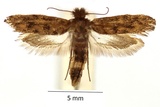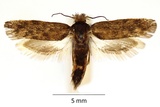Ochsenheimeria vacculella Fischer von Röslerstamm, 1842 Species
Last modified: July 23, 2025, 1:02 p.m.
A very rare species in Belgium, mentioned only from Brussels and Leuven (VB), nowadays (2000) possibly extinct. The species has declined sharply because rye, the main food plant, has become rarely planted in Belgium.
Details
- Classification
- Family: Ypsolophidae > Subfamily: Ochsenheimeriinae > Genus: Ochsenheimeria > Species: Ochsenheimeria vacculella
- Vernacular names
- Gebandeerde stekelmot (NL), Cereal Stem Moth (EN)
- First mention in Belgium
- De Fré Ch. 1858. Catalogue des Microlépidoptères de la Belgique. — Annales de la Société entomologique belge 2: 45–162. On page 114 (as P.[hygas] Vacculella. V. Heyd.; F. V. R.). view page
- Status
-
Native
Distribution
Egg
Eggs are characteristically deposited on interior wooden walls, ceilings, and straw bales or piles in outbuildings and on grasses from June through September. Eclosion occurs bimodally with around fifty percent of current season eggs hatching in late June and July. The remainder overwinters and hatch in February and March.
Caterpillar
Larvae are found in April and May. Light yellowish white body, prothoracic plate blackish brown, anal plate light brown.
Mine
First instar larvae typically mine leaves, later stadia are stem borers.
Bionomics
The young caterpillar mines in a leaf, after about a week they drill into the stem of the food plant. Young caterpillars are sometimes spread by the wind. In May and June, the larva pupates in a whitish flimsy cocoon between the leaves or in cracks of the food plant.
The adults are flying low to the ground at dawn. They are sometimes observed indoors, especially in barns.
Flight periods
The adults fly from June to August.
Observed on
- Host plant (genera):
- Lolium, Secale, Bromus, Poa, Festuca and Triticum
- Substrates:
- Cultivated crops and Grasses
The larvae feed mainly on Secale cereale (can reach pest status on that crop), but also on a variety of other grasses like Lolium, Bromus, Triticum, Poa, or Festuca.


